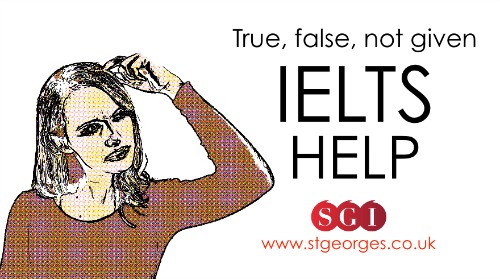
how do you answer IELTS true false or not given questions correctly?
Read on and you will learn the most accurate and quickest way to answer these IELTS reading test questions.
Some people call these questions, True/ False/No Information, or yes/no/no information, or T/F/NG
Do not get confused... they all mean the same thing!
In these type of questions, you will be given a short passage to read. Within that writing, there will be some relevant sentences that relate to the IELTS True/False/Not given questions.
You will be given a STATEMENT. Then you must decide if the information in the passage agrees with that statement (TRUE), or if the info disagrees with the statement (FALSE), or if there is no information regarding the statement (NOT GIVEN).
Let's just say that again in another way so that it is 100% clear...
- Information in the writing confirms your statement - TRUE
- Information in the writing contradicts your statement - FALSE
- Information in the writing is missing in connection with your statement - NOT GIVEN
True, False, Not Given IELTS Question Example
Let's take a look at a difficult T/F/NG question as an example. This question is from Cambridge IELTS book 10 (it is highly recommended to practise before your test with these books, so that you become super comfortable with the test questions)
EXAMPLE 1
Is this statement true, false or not given?:
Tourism has a social impact because it promotes recreation.
(This is the relevant sentence from the reading passage)
Tourism has a profound impact both on the world economy, and because of the educative effect of travel and the effects on employment, on society itself.
WHAT DO YOU THINK THE ANSWER IS?
Ask yourself these questions:
1. Does the sentence definitely and clearly say: "Tourism promotes recreation" ???
2. Does the sentence definitely and clearly say: "Tourism does not promote recreation" ???
If the answer to 1 is 'yes' = TRUE
If the answer to 2 is 'yes' = FALSE
If the answer to 1 and also 2 is 'no' = NOT GIVEN
CORRECT ANSWER: The sentence does not clearly say that tourism promotes recreation (1 = no). The sentence does not clearly state that tourism does not promote recreation (2 - no). Therefore, the correct answer is NOT GIVEN.
That was actually a really tricky example, so let's look at some easier example questions:
EXAMPLE 2
Grizzly bears usually begin hibernation in November and will get no water or nourishment. They survive on their accumulated fat stores for the next 5 to 6 months. Around March or April, male grizzly bears usually come out of their den, whereas females emerge in late April or May. The first food a grizzly bear eats is the carcasses of animals that died during winter. A grizzly bear will usually walk to lower elevations to reach snow-free areas that contain vegetation. This sometimes causes grizzly bears to come into direct conflict with humans who build their homes along the rivers that bears go to in order to find food.
Are these statements true, false or not given?
1. Male grizzly bears normally finish hibernating before the females of the species.
The relevant sentence is - Around March or April, male grizzly bears usually come out of their den, whereas females emerge in late April or May.
TRUE: Does the sentence definitely and clearly say: "Male grizzly bears finish hibernation before females" ??? YES!!!
FALSE: Does the sentence definitely and clearly say: "Male grizzly bears do NOT finish hibernation before females" ??? NO
Correct answer = TRUE
2. After hibernation, grizzly bears first search for berries.
The relevant sentences are - The first food a grizzly bear eats is the carcasses of animals that died during winter. A grizzly bear will usually walk to lower elevations to reach snow-free areas that contain vegetation.
TRUE: Does the sentence definitely and clearly say: "After hibernation, the first thing that grizzly bears do is to eat berries" ??? NO
FALSE: Does the sentence definitely and clearly say: "After hibernation, the first thing that grizzly bears do is NOT eat berries" ??? YES!!! It says that grizzly bears eat dead animals first.
Correct answer = FALSE
3. Grizzly bears are often killed by humans when they come into conflict as the bear searches for food near rivers
The relevant sentences are - A grizzly bear will usually walk to lower elevations to reach snow-free areas that contain vegetation. This sometimes causes grizzly bears to come into direct conflict with humans who build their homes along the rivers that bears go to in order to find food.
TRUE: Does the sentence definitely and clearly say: "Humans kill bears when they come into conflict" ??? NO
FALSE: Does the sentence definitely and clearly say: "Humans do not kill bears when they come into conflict" ??? NO
There is no information about humans killing grizzly bears
Correct answer = NOT GIVEN
IELTS T/F/NG TIPS
Do not think up your own answers - Some students give an answer according to what they THINK the answer should be. Do not do this. Only answer according to exactly what is written down in the writing passage!
Do not waste time if you think the answer is not given - Lots of students spend too much time looking for more and more information, if they think that the answer is not true or not false. If you can not find the information in 1 minute, do not keep looking to try and find the answer. Go with your gut instinct. Follow the "Does the sentence definitely and clearly say..." system above. If the information is missing, write NOT GIVEN, don't worry about it and quickly move on to the next question.
IELTS COURSES AT SGI
At SGI, we have a fantastic success rate with our IELTS courses in London.
Our experienced and highly-qualified teachers give students all the exam preparation they need to get the highest IELTS band scores.
There is a mock test every Thursday for all IELTS students with results the following day. This is absolutely the best way to prepare for IELTS: practise, practise and more practise!
If you have a question about studying on an IELTS course at SGI, then please contact us by email here
You can also see all of our free IELTS learning articles here...

